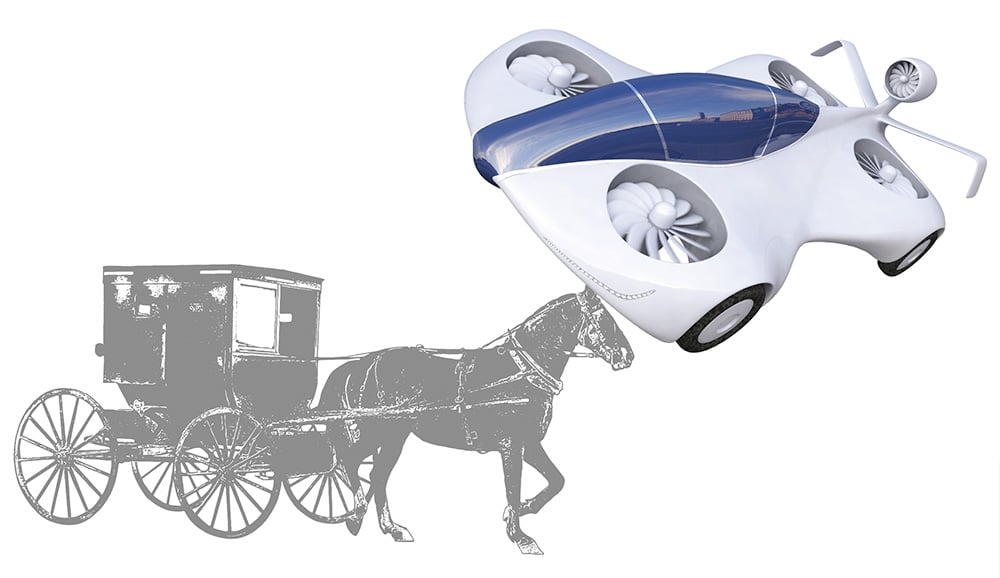
Board Perspective
From Horse and Buggy to Flying Cars
shutterstock / tnonra081, stock.adobe.com / costazzurra
Parking—We’ve Come a Long Way, Baby!
I’m old enough to remember using manual crank-style single-on-street meters – putting in pennies, nickels, dimes, and quarters to buy ‘parking’ time. It seems like a distant memory, but it wasn’t that long ago that the first smart meter was rolled out around 2002. Although, 20-plus years ago seems like ancient times.
Thinking about the evolution of parking, what has really changed? Parking has varied depending on human behavior, society, and technology. Our municipal leaders, developers, residents, and businesses have all handled parking planning, design, and construction.
Let’s look at the horse and buggy—this was the primary mode of transportation from the early 1800s to the early 1900s before 1908 and the widespread adoption of cars. Then came the construction of highways to accommodate cars. During the horse and buggy era, our communities had similar parking issues:
- Unregulated parking—a precursor to timed, on-street parking.
- Dedicated parking—a precursor to permit parking.
- Municipal stables—precursor to the garage.
- Shared roads with street cars—a precursor to curb management.
Many of the same parking principles were prevalent more than 200 years ago, focusing on efficient use of space, safety, and accessibility. I’m sure everyone wanted to park their horse and buggy right in front of where they were going, and there was plenty of ‘horse trading’ going on!
Our industry’s planning, design, and construction are ever-changing. We are constantly transitioning, and now more than ever, we are in a fast, chaotic space related to parking and mobility. Technology is changing faster than we can say ‘technology.’ As tech changes, so does human behavior and society.
Let’s look at what is going on right now. The parking industry is not just about parking operators: we are the drivers of technology and tech thought leaders, critical and connected partners leveraging parking dollars to create community sustainability, resiliency, and quality of life.
Technology is changing faster than we can say ‘technology.’ As tech changes, so does human behavior and society.
It’s all about parking. Every conversation with the public and private sector includes parking. Now, more than ever, it’s not just about how we operate garages but how we repurpose garages and evolve on-street parking to include curb management and monetization, shared mobility options, seamless mobility, apps, connected cars, and on-demand transportation options. We are living in a 24/7 world, juggling a macrocosm of outside forces coming at us fast and furious:
- Shared Roads. We are designing our cities and towns to create safe and accessible shared roads through curb management initiatives for all types of vehicles, transit, bikes, and pedestrians.
- Environmental Collaboration. The parking industry is part of the environmental path, including electric vehicle charger installations, green infrastructure initiatives to ensure water quality programming in our parking facilities, redesigning on-street parking and managing the curb, and decreasing carbon emissions related to delivery truck idling.
- Electric Vehicles. We are already seeing a fast pace and collaborative verticals mainstreaming electric vehicles as they take center stage in mixed-use development, zoning regulations, shared on-demand technology, funding, and manufacturing. With new emissions standards scheduled to take place by 2032, it is expected that 67% of new car sales will be electric.
- Autonomous/Self-Driving Vehicles. These have been in the planning, design, and testing phase. We still need to create safe, accessible, and affordable options, including construction and infrastructure changes and human behavior acceptance. The buzz is that this will be more accepted before 2030, but I’m still on the fence.
- Flying Cars. As we run out of planet Earth’s real estate, are flying cars that far off? Not really. It may seem like something out of a Jetson cartoon or Marvel movie, but it’s already in the planning, design, and testing phase. The construction and infrastructure phase will take some time, requiring our garages and other mixed-use developments to be repurposed and reconstructed to accommodate flying cars in a safe and accessible space.
- Shared Mobility. We are transitioning from vehicle ownership to on-demand subscription/membership shared mobility platforms, including on-demand transit, TNCs, electric vehicle chargers, electric vehicles, autonomous vehicles, and, yes, flying cars.
A lot is happening all at once! But let’s not forget that every community, every development, every town, and every city is at a different point in this ever-changing evolution. Demographics, population, geography, and behaviors are evolving at different paces. What works in one place will be different in another. With these differences come opportunities.
As leaders, we must recognize that our world is changing fast. We are responsible for educating our customers and constituents, partnering with each other, and being nimble.
Our industry is at the epicenter of changing our world and our future. We’ve come a long way, baby. Giddyap! ◆
-
Kathryn Hebert, PhDhttps://parking-mobility-magazine.org/author/kathryn-hebert-phd/November 8, 2021
-
Kathryn Hebert, PhDhttps://parking-mobility-magazine.org/author/kathryn-hebert-phd/December 5, 2022
-
Kathryn Hebert, PhDhttps://parking-mobility-magazine.org/author/kathryn-hebert-phd/December 28, 2022


Carrying the Torch
The path to success unquestionably requires the courage to lead,

Seven-Generation Decision-Making
A major factor of sustainability is thinking about how we









